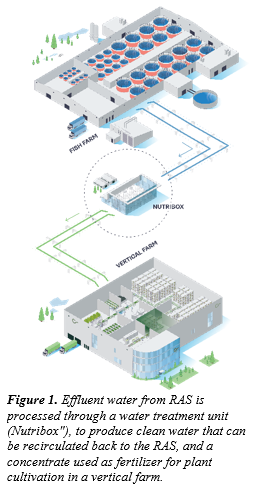CONCENTRATED NUTRIENTS RECOVERED FROM EFFLUENT WATER FROM RECIRCULATING AQUACULTURE SYSTEM (RAS) USED AS FERTILIZER IN A HYDROPONIC FARM
Introduction
The transition to a circular bioeconomy hinges on innovative green technologies able to recycle waste streams into reusable components. This study investigates a pilot-scale system for nutrient recovery from recirculating aquaculture system (RAS) effluent water employing membrane technologies for fertilizer production. The innovation could provide the Norwegian aquaculture sector with an alternative to discarding RAS effluent water, potentially making the industry more sustainable by reducing eutrophication and the need for wastewater treatment. Moreover, the production of a novel recirculated fertilizer product from RAS effluent water might alleviate the dependency on mineral fertilizer across agricultural sectors. For instance, Norwegian agriculture consumed 87,000 tons of nitrogen and 7,000 tons of phosphorus mineral fertilizer in 2023 . This dependency poses significant challenges due to the energy-intensive production of nitrogen fertilizers, which represents 2 % of the global energy consumption and the emission of 450 mT CO2 annually .
The primary goals of the study were to evaluate the performance of the water treatment system when producing a concentrate intended as fertilizer from RAS effluent water, to assess the storage stability of the produced fertilizer with and without pasteurization, and to assess the concentrates suitability as a fertilizer. By measuring the input and output streams of the water treatment system over time, the study aimed to determine system performance and compare the composition of the resulting concentrate to plant nutrient requirements. Additionally, the chemical and microbiological storage stability of pasteurized concentrate was monitored for six months and compared to an unpasteurized control. The concentrates suitability as a fertilizer was tested through plant cultivation trials in a hydroponic farm.
Materials and methods
A pilot system consisting of a research scale RAS facility, a water treatment system, and a vertical farm was built and operated for the project duration of three years, located at the research station of NIBIO Landvik, Norway. The RAS system consisted of two 1,000 L fish rearing tanks with Salmo salar grown at a density between 70 – 100 kg/m3, a moving bed biofilter, CO2 scrubber, oxygenation, pH regulation and a hydrocyclone and drum filter for sludge removal. All RAS effluent water of 900 – 1,200 L/ week was processed in batches of 300 L through the water treatment system to produce a nutrient rich concentrate and clean permeate. The storage stability of pasteurized and unpasteurized concentrate was assessed through a six-month shelf-life study monitoring chemical and microbiological changes. Meanwhile, the concentrates potential as a fertilizer was assessed through plant cultivation studies in a 6.72 m2 hydroponic vertical farm.
Results and discussion
The water treatment system used RAS effluent water to produce a concentrate with a high element ratio of the plant macro nutrients nitrate and potassium. However, the extract was low in phosphorous due to the low contents of water soluble phosphate in the RAS effluent water. Preliminary results from the hydroponic cultivation trials indicated that RAS concentrate enriched with mineral fertilizer achieve plant yields comparable to the mineral fertilizer control treatment. In the shelf-life study the RAS concentrate was found to be microbially and chemically stable for at least six months regardless of pasteurization.
The study show that concentrated RAS effluent water can be used as a fertilizer in plant cultivation, which have the potential to alleviate the consumption of mineral fertilizer while simultaneously decreasing the eutrophication potential of commercial RAS systems by collecting and using discharged nutrients. In future studies, efforts should be made to concentrate the fertilizer further to make distribution to a global marked more feasible, asses the economic and environmental feasibility of a scaled-up system and investigating the impact on fish-health when recycling water cleaned by the developed water treatment system back to the RAS.
This research is part of the IPN Nutricycle project, and is funded by the Research Council of Norway (grant number # 336971)
